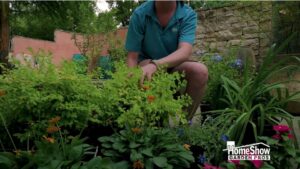Houston Organic Garden Tips & Advice
How To Build A Soil Bed
Transcript:
Sandie:
Hi, I’m Sandie.
Sherri:
And I’m Sherri, with HomeShow Garden Pros.
Sandie:
And we are here with Leo, from Nature’s Way Resources. And we have got a fun example of how to build a bed.
Leo:
So pretty much trying to build the soil structure to promote root growth, because a lot of the plants, the roots can sense where the nutrients are, and it causes it to grow deeper into the soil. So we have right here as an example of an in-ground bed that we’re doing, like a raised garden bed in ground or like a flower bed. So the bottom section is going to be like your native soil, which is going to be either really sandy or really clay-heavy. And what we did is we added some of our garden and flower bed mix, which is a good all-around mix. It has a little bit of sand, it has a little bit of compost for drainage. And then the next thing we added was some compost. So we’re going to add a little bit more of that garden and flower bed mix. And then we’re going to add a little bit more of some compost, followed with some mulch.
Sherri:
Right. So if you could actually look underground and mimic this in your flower beds, you’d have a really good experience with your results in your garden.
Leo:
Exactly.
Sandie:
Nice. Okay, we’ve got a couple of layers here right now. So what would we do? What would you pour in next?
Leo:
So we’re going to put some more garden and flower bed mix to help with the drainage.
Sandie:
Okay. This seems a little … It’s more thin than the compost, right?
Leo:
Yes.
Sherri:
So smaller particles?
Leo:
Yep. So if you look at the main differences between soil, the sand, the silt and the clay, it’s just going to be the particle size. So the smallest particle size is going to be the clay soil. And that’s why it’s hard for water to pass through it, because it’s just so compact. Then you’ve got sandy, sandy clay, that’s going sandy. All right, so that’s the garden and flowerbed mix that has a combination of sand and compost, and the topsoil as well.
And the difference between the particle sizes is the clay is going to have the smallest particle size, and then the sand’s going to have the bigger particle size. And the silt is going to be in between. And you have the clay soil that’s going to be hard for the water to pass through, because the particles are so small. And then you have the sand that’s going to be a little bigger, so the water can seep through it. It’s good for drainage. So now that we added that layer, we have the next layer, which is going to be some more compost.
Sherri:
And the reason we do these layers and we go up in our gardens is because we do get those heavy rains, right?
Leo:
Yes.
Sherri:
And so we want to make sure our roots can always breathe and have oxygen?
Leo:
Correct, correct. And this compost being closer to the top, as it breaks down, it’s going to add more nutrients down into the soil as we’re watering, and the nutrients are going to seep down.
Sherri:
And this is your leaf mold compost, right?
Leo:
Yes, correct.
Sherri:
And the leaf mold compost is super biologically active, just beautiful compost?
Leo:
Yes. So it’s going to have a lot of the beneficial microbes, the bacteria, the fungi that builds that symbiotic relationship with the plants at the root rhizomes, where it’s getting exited from the roots that are releasing the sugary liquids, and then helping it gather more nutrients. You see a lot of the fungi builds little webs and stuff and helps extend the roots.
Sandie:
Big, happy family.
Sherri:
Right. Super important, right?
Leo:
Mm-hmm.
Sandie:
All right, so what is our next layer after the compost?
Leo:
So the next layer is going to be the mulch, and that’s just going to be topping it off. The three main purposes of the mulch is to retain the water moisture, also to prevent the weeds from growing, and the third is actually to regulate the temperature of the soil to protect those beneficial microbes.
Sherri:
Which is super important in our extreme heat.
Sandie:
Right. I was just using some of this the other day.
Sherri:
And how thick of a mulch layer do you recommend?
Leo:
You want to do about anywhere from two to three inches, depending on some varieties, like blueberries prefer a little bit thicker, anywhere from four to five inches. And it just depends on the weather too. If you’re going to be going into the colder season, you definitely want to have a thicker layer as well, because it’s going to help keep the temperature warm in the soil as well.
Sandie:
Great.
Sherri:
Awesome. And then real quick, the difference between compost and mulch is the particle size, right?
Leo:
Yeah, so the compost is more like amendment, with the nutrients, and then the mulch. And our mulch is specifically not like bark mulch where it’s just the outer layers of the tree. It’s the whole actual trees and the limbs that have a lot of the nutrients. Sometimes you see deers and other animals use the limbs of the trees, because they have more nutrients in them. And that’s funneling the nutrients to the leaves or the fruit that it’s growing.
Sherri:
All right. And then the mulch has got that shredded nature. So it kind of locks down and keeps all your nutrients and your good compost from washing down the street.
Leo:
Correct. And as this just breaks down, it just becomes more and more nutrients, like old saying says, “This year’s mulch is next year’s compost.”
Sherri:
Awesome.
Sandie:
I love that. It’s a cycle. Well, thanks very much, Leo, from Nature’s Way Resources. And you can find more tips like this and listen to us on Saturday mornings at HomeShow Garden Pros.



